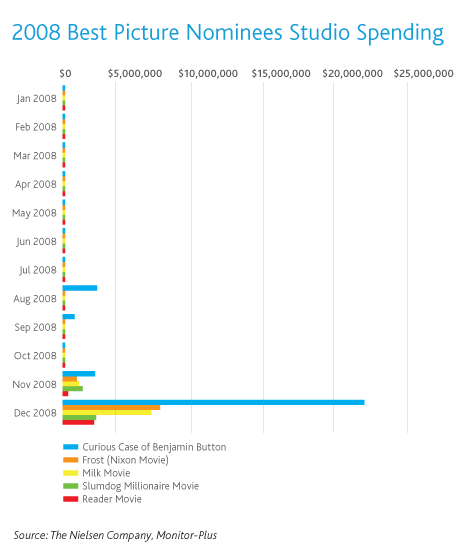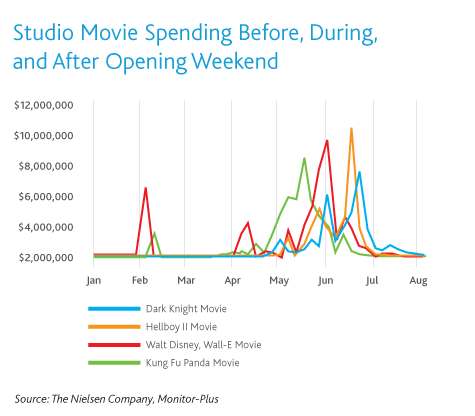Virginia Harvey, Client Service, Nielsen Monitor-Plus
SUMMARY: What defines the ultimate success of a movie—generating high box-office sales results, building a successful brand franchise or earning the ultimate honor of winning an Academy Award? While the answer is likely a mix of the three and certainly arguable, one thing is for certain—considerable advertising spending correlates to a high-degree of success.
| There was a definable trend among the five lucky nominees… |
Slumdog Millionaire—perhaps the biggest sleeper surprise movie of 2008—took home the Oscar for Best Picture. Although this was not a summer blockbuster flick, nor were any of the other nominees in this prestigious category, there was a definable trend among the five lucky nominees—all were primarily advertised in the second half of the year with a concentration during the fourth quarter.
Additionally, all of the films were released within the months of November and December. With only a month or two before nominations are announced by the Academy of Motion Picture Arts & Sciences (AMPAS), movie studios are well aware that the chances of a nomination are far greater when a picture is released at the end of the year. And the trends prove this theory. A review of the past five years reveals that only one film was released outside of the fourth quarter: With a release date of early May, Crash took home the 2005 Best Picture Academy Award.

| The top 10 movies in 2008, based on advertising spending included four films with nominations… |
Summer spending pays off
Let’s not dismiss summer flicks just yet! The top 10 movies in 2008, based on advertising spending from May through August, included four films with nominations— albeit not for Best Picture. The top movie—Kung-Fu Panda—spent (specifically for the film) $40 million in advertising with a release date of early June. According to Nielsen, opening weekend sales at the box office totaled $60.2 million. Competing with Kung-Fu Panda for Best Animated Film was Wall-E coming in right behind at $38.4 million in studio ad spending. The total weekend sales were $63.1 million for this much-anticipated Pixar film.
Wall-E earned six nominations ranging from Best Score to Original Screenplay and even took home the Oscar for Best Animated Film. And the soundtrack for the film sold 39,000 copies since its release in late June through first quarter 2009, according to Nielsen. Two other summer blockbusters—Hellboy II and The Dark Knight—both garnered nominations in the Best Makeup category. Ad spending for Hellboy II rounded off just under $32 million and similarly, The Dark Knight spent $31.5 million. The Dark Knight also scored a win for Best Supporting Actor, Heath Ledger.

In like a lion—out like a lamb
Unlike everyday products, advertising for motion pictures relies on building pre-show excitement and then tapers off dramatically after the movie release. As the chart below indicates, the spikes in spending for the 2008 summer-nominated films occurred just prior to release. Exceptions exist, however, when studios will spend big bucks much sooner than that crucial week before opening day. The Walt Disney Company spent a whopping $5.2 million on a 60-second Super Bowl spot to promote Wall-E nearly four months prior to the release of the film.
Word of mouth, however, is still one of the most powerful forms of advertising. In the end, it doesn’t matter much whether the movie is a hit or miss with critics; it’s the viewing public that ultimately decides the commercial success of the film.

| Build a brand franchise that extends far beyond the actual movie release… |
Complementary cohorts
Building a brand franchise that extends far beyond the actual movie release can be a successful, yet costly endeavor. McDonald’s is presumably one of the more notable companies for this type of advertising when it comes to movies that are marketed to kids. Nielsen reports that from May through August 2008, McDonald’s teamed up with Kung Fu Panda to offer Happy Meal toys with a combined budget of $5.7 million. And Dominos spent double that amount—$11.6 million—when they paired up with The Dark Knight franchise.
Perhaps most will recall the famous 1982 scene of Steven Spielberg’s E.T. when Elliot uses Reese’s Pieces candies to lure the alien out of hiding. It has been noted that M&M’s passed up the offer from the studio, but Reese’s gladly accepted, reaping all benefits (and sales) after the release of the film.
Not only do placements appear in movies, but the movies themselves appear in today’s television programs. Looking across cable and broadcast network programming from May through August, The Dark Knight had a total of three occurrences in The Big Bang Theory. Hellboy II had 22 occurrences in shows such as Americas Got Talent and Last Comic Standing; and finally, Kung Fu Panda totaled 72 occurrences within various cable and network programs. The type of placements ranged from a dialog mention to an in-scene promotion where a character from the film appeared on the screen for several seconds.
| Spending translates to box office sales… |
Building success
Regardless of a possible nomination, movie studios know that advertising spending is a critical contributing factor to the success of a film. Simply stated, spending translates to box office sales. The nomination is the whip cream and the win is the cherry on top. Out of the four 2008 summer-nominated films, The Dark Knight had cumulative total sales of $533.3 million, which towered over Wall-E’s more-than-respectable $223.8 million cumulative total—certainly worth the advertising dollars spent on promotion. With the 2009 summer movie season upon us, only time will tell which ones will leave a lasting—or even indelible—mark on the hearts and minds of viewers. No doubt, those that do will have a strong advertising budget to support their success.



